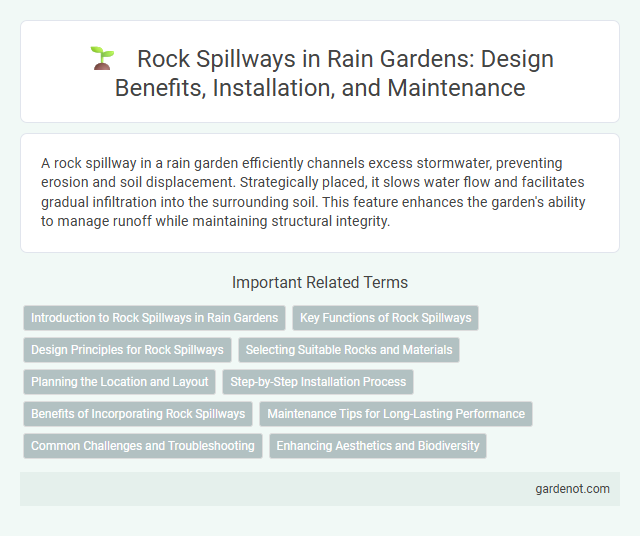A rock spillway in a rain garden efficiently channels excess stormwater, preventing erosion and soil displacement. Strategically placed, it slows water flow and facilitates gradual infiltration into the surrounding soil. This feature enhances the garden's ability to manage runoff while maintaining structural integrity.
Introduction to Rock Spillways in Rain Gardens
Rock spillways in rain gardens effectively manage excess stormwater by directing overflow through a controlled path of strategically placed rocks. These engineered channels reduce erosion, promote infiltration, and enhance the garden's ability to handle heavy rainfall events. Incorporating durable, angular rocks ensures stability while facilitating water flow and maintaining the garden's ecological balance.
Key Functions of Rock Spillways
Rock spillways serve as critical components in rain garden design, efficiently directing excess stormwater away from the garden to prevent erosion and flooding. They stabilize flow paths by dissipating energy from runoff, reducing soil displacement and maintaining the structural integrity of the rain garden. These engineered channels enhance water infiltration and protect surrounding landscapes by controlling peak discharge during heavy rainfall events.
Design Principles for Rock Spillways
Rock spillways in rain gardens are designed to manage stormwater flow by controlling erosion and facilitating infiltration. Key design principles include selecting appropriately sized, durable stones to withstand high-velocity water and arranging them to create a stable channel that dissipates energy. Incorporating a gradual slope and proper alignment ensures efficient water conveyance while protecting surrounding soil and vegetation.
Selecting Suitable Rocks and Materials
Selecting suitable rocks and materials for a rain garden rock spillway involves choosing durable, weather-resistant stones such as granite or basalt to withstand water flow and erosion. The rocks should vary in size, from large boulders for stability to smaller gravel that facilitates drainage. Incorporating permeable materials like crushed stone enhances water infiltration and supports the garden's overall stormwater management.
Planning the Location and Layout
Selecting the location and layout of a rock spillway within a rain garden involves analyzing topography to identify the lowest elevation point where water naturally flows. Designing the spillway to accommodate peak stormwater volumes ensures effective overflow management while preventing erosion. Integrating native, durable rocks aligned with the garden's drainage patterns optimizes both functionality and aesthetic harmony.
Step-by-Step Installation Process
Install a rock spillway by first excavating a shallow channel from the rain garden overflow point to a stable outlet to control water flow. Line the channel with landscape fabric to prevent soil erosion, then layer angular river rocks or gravel at least 6 inches deep to allow water infiltration and dissipate energy. Secure the rocks by tamping them firmly and ensure the spillway slope facilitates smooth drainage away from structures while maintaining natural aesthetics.
Benefits of Incorporating Rock Spillways
Rock spillways in rain gardens enhance stormwater management by directing runoff safely, preventing soil erosion, and reducing sediment buildup. These durable structures improve water infiltration and slow runoff velocity, promoting groundwater recharge and mitigating flooding risks. Incorporating rock spillways also increases the garden's longevity and reduces maintenance by stabilizing overflow paths during heavy rain events.
Maintenance Tips for Long-Lasting Performance
Regularly inspect the rock spillway for debris buildup and remove leaves, sediment, or other obstructions to ensure efficient water flow and prevent blockages. Check the integrity of rocks and replace any displaced or damaged stones to maintain structural stability and prevent erosion. Periodic cleaning combined with vegetation management around the spillway helps sustain its performance and durability over time.
Common Challenges and Troubleshooting
Rock spillways in rain gardens frequently face erosion due to high flow rates and improper placement of rocks, leading to soil displacement and reduced garden effectiveness. Common challenges include clogging from debris buildup and stone shifting during intense storms, which can obstruct water flow and cause overflow damage. Regular inspection and maintenance, such as repositioning displaced rocks and clearing debris, are essential to ensure proper drainage and prevent structural failure.
Enhancing Aesthetics and Biodiversity
Rock spillways in rain gardens create visually appealing, naturalistic water features that enhance garden aesthetics while promoting biodiversity. The varied rock sizes and textured surfaces provide habitats for amphibians, insects, and microflora, supporting a diverse ecosystem. These spillways improve water flow management and encourage native plant growth, further boosting ecological health and visual interest.
Rock spillway Infographic

 gardenot.com
gardenot.com